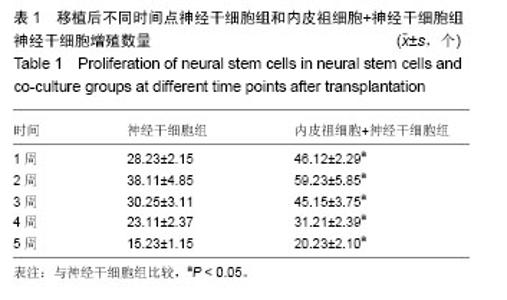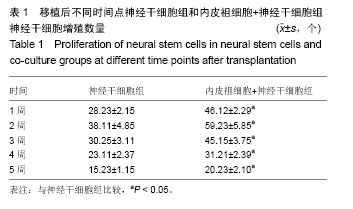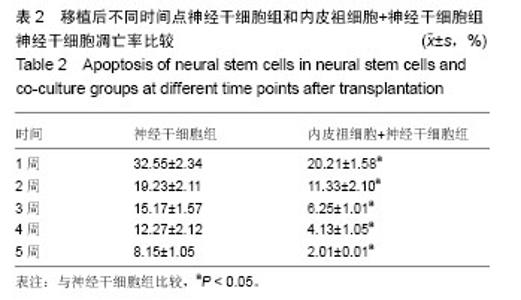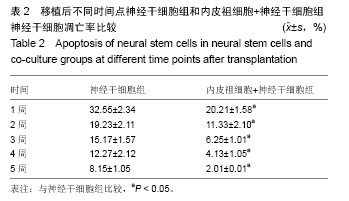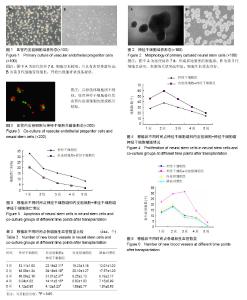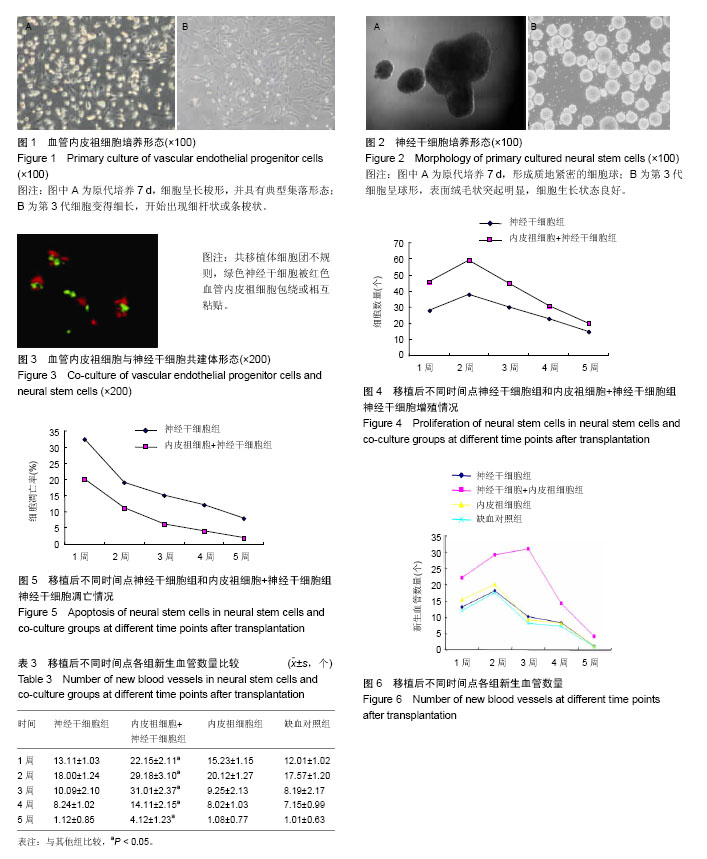| [1] 富奇志,齐志国,朱晓峰,等.血管内皮祖细胞对共同植入缺血再灌注模型大鼠脑内的神经干细胞增殖、凋亡和血管形成的调节[J].第三军医大学学报,2010,32(6):511-515.[2] 齐志国,朱晓峰,富奇志,等.神经干细胞与血管内皮祖细胞共移植促进移入缺血再灌注模型大鼠脑内神经干细胞向神经元分化和突触的形成[J].第三军医大学学报,2010,32(7):625-629.[3] Wang PH, Schwindt TT, Barnabé GF, et al. Administration of neural precursor cells ameliorates renal ischemia-reperfusion injury. Nephron Exp Nephrol. 2009;112(1):e20-28.[4] 鲁友明.内皮祖细胞对神经干细胞增殖分化及Notch信号分子表达的影响[D].南昌:南昌大学医学院,2008.[5] Asahara T, Murohara T, Sullivan A, et al. Isolation of putative progenitor endothelial cells for angiogenesis. Science. 1997; 275(5302):964-967.[6] 李政.内皮祖细胞调控神经干细胞分化及其机制研究[D].重庆:第三军医大学,2010.[7] 张磊.不同途径细胞联合移植对大鼠脑缺血损伤治疗的影响[D]. 衡阳:南华大学,2014.[8] 薛杉.生物工程材料介导的成体干细胞移植治疗大鼠脑损伤修复的实验研究[D].广州:南方医科大学,2010.[9] Guan Y, Zou H, Chen X, et al. Ischemia, immunosuppression, and SSEA-1-negative cells all contribute to tumors resulting from mouse embryonic stem cell-derived neural progenitor transplantation. J Neurosci Res. 2014;92(1):74-85.[10] 张文学.血管内皮祖细胞治疗大鼠创伤性脑损伤的实验研究[D]. 天津:天津医科大学,2008.[11] 杜公文,杜怡斌,张辉,等.血管内皮祖细胞在脊髓损伤修复中的研究进展[J].中国矫形外科杂志,2013,21(14):1423-1426.[12] 董漪,董强.血管内皮生长因子与卒中及神经系统退行性疾病[J].中国卒中杂志,2009,4(2):152-158.[13] 王玉琳.转入VEGF基因的血管内皮祖细胞移植对AD模型小鼠治疗的实验研究[D].沈阳:中国医科大学,2011.[14] 涂雪松.干细胞移植治疗缺血性脑血管病实验研究进展[J].中国脑血管病杂志,2014,11(8):440-445.[15] Kwon O, Miller S, Li N, et al. Bone marrow-derived endothelial progenitor cells and endothelial cells may contribute to endothelial repair in the kidney immediately after ischemia-reperfusion. J Histochem Cytochem. 2010;58(8): 687-694.[16] Stellos K, Langer H, Gnerlich S, et al. Junctional adhesion molecule A expressed on human CD34+ cells promotes adhesion on vascular wall and differentiation into endothelial progenitor cells. Arterioscler Thromb Vasc Biol. 2010;30(6): 1127-1136.[17] 张彤,林涛,王秀志,等.电针预处理对脑缺血再灌注大鼠骨髓和血浆中EPCs及VEGF的影响[J].中国康复医学杂志,2009,24(5): 428-432.[18] 余毅,谢福安,王琰,等.内皮祖细胞骨移植在缺血再灌注肾损伤中的促血管新生作用[J].世界临床药物,2009,30(2):72-75.[19] Chen B, Gao XQ, Yang CX, et al. Neuroprotective effect of grafting GDNF gene-modified neural stem cells on cerebral ischemia in rats. Brain Res. 2009;1284:1-11.[20] 陈镇洲.体外扩增骨髓基质细胞、血管内皮祖细胞自体移植治疗脑缺血的实验研究[D].广州:第一军医大学,2007.[21] 程康,王海昌,周祥,等.小肠RNA对缺血再灌注条件下移植小型猪骨髓内皮祖细胞的体外干预效应观察[J].医学研究杂志, 2010, 39(12):29-34.[22] 李霞.麦冬多糖-1对心肌缺血再灌注大鼠内皮祖细胞与缺血修饰白蛋白变化的影响[J].中国老年学杂志,2015,35(19): 5449-5450.[23] Bo CJ, Chen B, Jia RP, et al. Effects of ischemic preconditioning in the late phase on homing of endothelial progenitor cells in renal ischemia/reperfusion injury. Transplant Proc. 2013;45(2):511-516.[24] 张旭东,王也,刘然,等.脑缺血预处理对大鼠外周血内皮祖细胞及血管新生的影响[J].中国神经精神疾病杂志,2015,41(1):10-14.[25] 梁伟钧,王苗,张日霖,等.阿托伐他汀对缺血再灌注损伤下内皮祖细胞的保护作用[J].国际心血管病杂志,2013,40(1):49-52.[26] 赵平,黄诚胤,聂涛,等.运动训练对脑缺血再灌注后内皮祖细胞的影响[J].成都体育学院学报,2010,36(7):67-71.[27] 高洪博,王翠兰,荆静,等.局灶性脑缺血再灌注损伤大鼠外周血内皮祖细胞数量的变化及其意义[J].临床神经病学杂志,2010, 23(5):355-358.[28] Stellos K, Langer H, Gnerlich S, et al. Junctional adhesion molecule A expressed on human CD34+ cells promotes adhesion on vascular wall and differentiation into endothelial progenitor cells. Arterioscler Thromb Vasc Biol. 2010;30(6): 1127-1136.[29] Bolego C, Rossoni G, Fadini GP, et al. Selective estrogen receptor-alpha agonist provides widespread heart and vascular protection with enhanced endothelial progenitor cell mobilization in the absence of uterotrophic action. FASEB J. 2010;24(7):2262-2272.[30] 王苗.阿托伐他汀对缺血再灌注损伤下内皮祖细胞的保护作用及其机制研究[D]. 湛江:广东医学院,2012.[31] 孙剑瑞,殷德涛,周金桥,等.神经生长因子对神经干细胞增殖、分化和凋亡的影响[J].中华实验外科杂志,2011,28(8):1350-1352.[32] 刘建民,毛伯镛.神经干细胞与血管内皮祖细胞共移植治疗缺血性脑卒中的研究进展[J].中国修复重建外科杂志,2007,21(2): 204-208.[33] 杜公文,杜怡斌,张辉,等.共培养下内皮祖细胞对神经干细胞增殖及分化的影响[J].安徽医科大学学报,2013,48(12):1445-1448, 1449.[34] 陈波,薄成佳,贾瑞鹏,等.内皮祖细胞在早期急性肾缺血再灌注损伤中的抗凋亡作用观察[J].东南大学学报:医学版,2012,31(5): 581-585.[35] 朱俊德,王贵学,余彦,等.内皮祖细胞移植对动脉粥样硬化模型大鼠脑缺血再灌注后学习记忆能力与脑顶叶皮质的影响[J].解剖学报,2012,43(4):433-438.[36] 李崇剑.经皮冠脉内自体骨髓单个核细胞和外周血内皮祖细胞移植对小型猪心肌缺血再灌注损伤的作用研究[D].北京:中国协和医科大学,2005.[37] 李崇剑,高润霖,杨跃进,等.猪心肌缺血再灌注损伤区自体骨髓单个核细胞和外周血内皮祖细胞移植后细胞分化探讨[J].中华心血管病杂志,2007,35(4):350-353.[38] 高洪博.局灶性脑缺血再灌注损伤大鼠外周血内皮祖细胞数量的变化及其意义和机制[D].济南:.山东大学,2010. |
